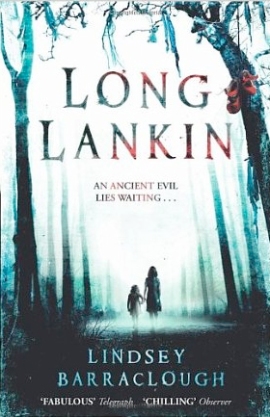I found this book in the children’s section of my local library. Well, I don’t know about kids, but it honestly creeped the crap out of me, and that has not happened in a long, long time. Despite the youth of the characters, I’d have put it in the adult section. With a warning on the cover.
It was the title that made me take it off the shelf. “Long Lankin” is one of the old ballads that had the Steeleye Span treatment back in the 70s, and it sticks with you.
Beware the moss, beware the moor; beware of Long Lankin…
For some reason I always imagined the moor to be in Yorkshire, but Lindsey Barraclough has taken her cue from the “moss”, setting her tale in East Anglia’s sucking fens.
Be sure the door is bolted well, lest Lankin should creep in…
Back then, I heard it as merely the story of a murder, but according to wiki, “It gives an account of the murder of a woman and her infant son by a man… a devil, bogeyman or a motiveless villain… [later] versions add peculiar incidents that add to the grisliness of the crime. Lamkin and the nursemaid collect the baby’s blood in a basin which, along with the idea that the name Lamkin or Lammikin indicates the murderer was pale skinned and, therefore, perhaps a leper who sought to cure himself by bathing in the blood of an innocent collected in a silver bowl, a medieval cure.” These are key elements in the book.
Told from three viewpoints, the setting is the Fifties. Cora and her four-year-old sister Mimi are sent to stay with elderly Aunt Ida in her crumbling mansion. Their aunt REALLY doesn’t want them there, fobids them to explore the nearby church, and all the windows in the house are nailed shut. The girls befriend a local boy, Roger, and his small brother Peter. I was instantly catapulted back to my own childhood. Barraclough’s writing is pitch-perfect, the kid’s sounding just as I remember from a small country town in the Sixties (“he can’t run for toffee”).
The first three-quarters of the book are a spine-chilling masterclass in Jamesiana, adhering closely to the Ominous Thing rule: “into this calm environment let the ominous thing put out its head, unobtrusively at first, and then more insistently, until it holds the stage.”
Fans of Monty will appreciate this image: “Moving slowly, creeping along the ground, it approached a bright patch of moonlight by the wire fence. It is shaped like a long tall man, yet it crawls like an animal.”
They will also recall a hand similar to this one, “with thin, almost transparent, blotched flesh, crooked, bony fingers and curved black fingernails like iron claws, reached out and curled around the edge of the doorway.”
And indeed this: “It [the window] was thickly covered with huge flies, crawling over the diamond panes, their fat black and white bodies packed tightly together. Flesh flies— flies that don’t bother to lay eggs, just maggots.”
By this time I was looking apprehensively at the darkness outside, and wondering what could possibly come next.
However, Lankin, when he materialises in suitably horrible form, lurches into a dramatic, but less scary, battle for little Mimi, in which Aunt Ida plays a surprisingly heroic role. It’s not exactly an anticlimax and it’s not un-thrilling, but it’s a little more conventionally horror-story than the subtle build-up. And, by golly, it ends on a completely unexpected cliffhanger. There is a sequel in the pipeline. I hope Lindsey Barraclough has been writing like fury, because I want to know what could possibly come next.

